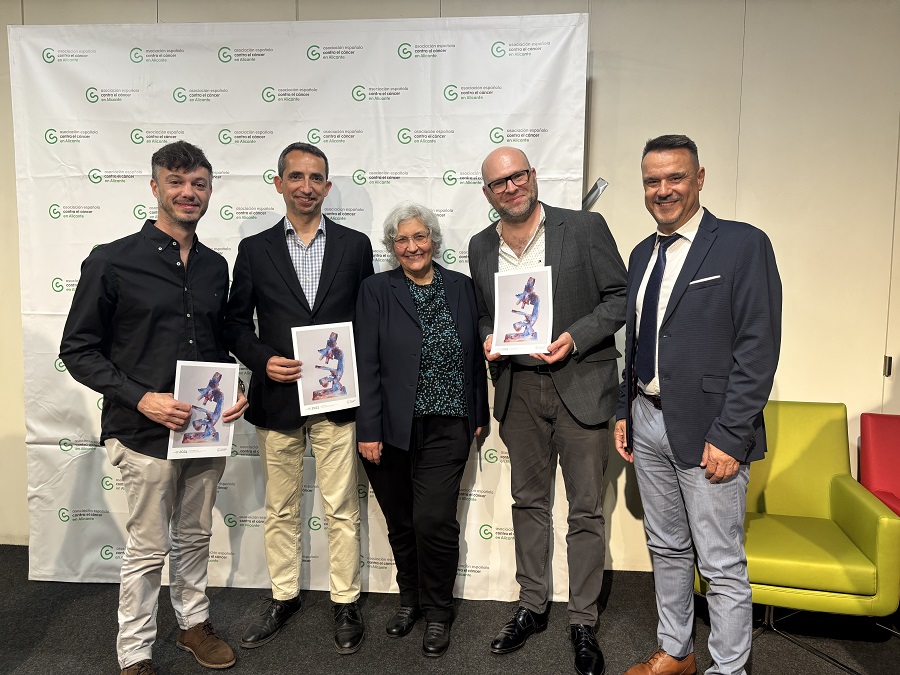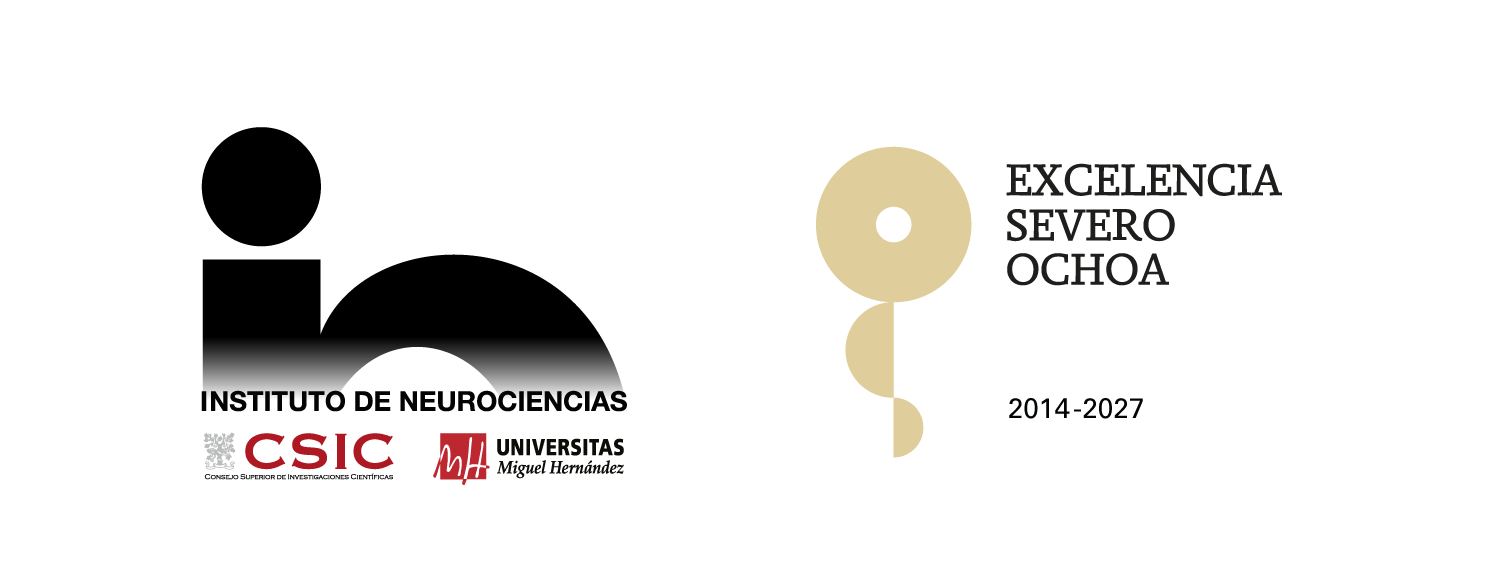Five projects from the Institute for Neurosciences CSIC-UMH receive AECC grants for cancer research
29 de April de 2025
- The Spanish Association Against Cancer (AECC) has presented in Elche its research grants for the province of Alicante, amounting to a total of €658,535.
- Researchers Khalil Kass Youssef, Víctor Borrell, Mario Aguilar, and Teresa Guillamón are leading research projects funded by this association.
With the aim of recognizing and supporting local research talent, the Spanish Association Against Cancer in Alicante held a presentation event yesterday for the projects that have received AECC Research Grants in the province. The event took place at the Elche Congress Center and included a roundtable discussion featuring several awardees from the Institute for Neurosciences (IN), a joint center of the Spanish National Research Council (CSIC) and Miguel Hernández University of Elche (UMH). The ongoing projects were presented during the event, with six grants totaling €658,535.

Photo: Researchers Mario Aguilar, Víctor Borrell, and Khalil Kass together with the director of the Institute of Neurosciences, Juana Gallar, and the UMH Vice-Rector for Research and Knowledge Transfer, Ángel Carbonell.
The roundtable, titled ‘Boosting Cancer Research in Alicante’, featured IN researchers Víctor Borrell, Khalil Kass Youssef, and Mario Aguilar, who shared the main goals of their projects and their relevance to patients. The researchers expressed their gratitude and emphasized that the association’s support will allow them to develop innovative research that could, in the long term, transform scientific results into solutions that improve patients' quality of life.
A mutant model to study pediatric cancer
The project led by Víctor Borrell focuses on designing therapies against ETMR, a very rare type of brain tumour affecting infants. This type of cancer is characterized by the presence of a large, solid brain tumour made up of cells that divide indefinitely, leading to tumour growth.
The Neurogenesis and Cortical Expansion laboratory, led by Borrell at the IN, has developed a mutant mouse model that exhibits brain tumours similar to ETMR in children. "The cellular and genetic characteristics of the tumours in this mouse model make it a faithful representation of the disease," the researcher highlights. His team’s goal is to discover the type of cell that mutates in healthy embryos and begins to form the tumour, as well as the genes or molecules that become altered: "This way, we can use what we learn to design and test new drugs that could reduce or halt the growth of these tumours in mutant mice", Borrell explains.
Mechanisms of tumour invasion
Researcher Khalil Kass Youssef has been awarded two AECC-funded projects. Through the first, he studies the role of neurons in the progression of breast cancer towards malignancy and therapy resistance. "The development and spread of malignant tumours depend on the interaction of cancer cells with the tumour microenvironment. These cells can act on neurons and modify nearby neural circuits to promote tumour growth and invasion", explains Youssef, who is part of the Cell Plasticity in Development and Disease laboratory led by Ángela Nieto at the IN.
The goal of this project is to develop a new technology for genetic lineage tracing within the tumour microenvironment to understand the interactions between cancer cells and peripheral nervous system neurons in a metastatic breast cancer model. "We want to understand how these interactions promote malignancy and metastasis formation", Youssef emphasizes.
The second project will be carried out in collaboration with Professor Isabel Fabregat’s laboratory at the Bellvitge Biomedical Research Institute (IDIBELL) in Barcelona. The team will study the mechanisms of tumour invasion in bile duct cancer, known as cholangiocarcinoma. Although rare, these tumours are highly lethal and resistant to therapies, especially at the metastatic dissemination stage.
To achieve this, they will establish a three-dimensional model where cholangiocarcinoma cells are cultured alongside neurons, using advanced microscopy technologies to follow the invasion and migration processes over the neurons closely. "We want to use this 3D model to study the genetic and epigenetic programs that drive invasion, aiming to identify new therapeutic targets to improve the treatment for patients with this type of cancer", Youssef explains.
The brain’s reward system to accelerate recovery
Researcher Mario Aguilar, part of the Mechanisms of Growth Control and Cancer laboratory led by María Domínguez at the IN, leads a project that will study the relationship between cancer cells, the brain's reward system, and immune system cells using the fruit fly model (Drosophila melanogaster).
The team will use advanced imaging techniques, molecular analysis, and patient database studies to characterize the molecular mechanisms influencing the dopaminergic system. "This project will allow us to deeply investigate the mechanisms behind the placebo effect, and the results could offer insights to optimize current treatments from a holistic perspective", Aguilar notes.
Additionally, researcher Teresa Guillamón from the Development, Plasticity and Reprogramming of Sensory Circuits laboratory, directed by Guillermina López-Bendito at the IN, is leading a project aimed at understanding the effects of brain cancer on the activity of neurons and astrocytes at a global level. Her team uses a brain metastasis model in transgenic mice and records activity throughout different stages of the disease. The objective is to find a correlation between activity changes and disease progression and tumour location, to use these recordings as a potential diagnostic tool or disease predictor.
About the Spanish Association Against Cancer (AECC)
The Spanish Association Against Cancer has been the leading organization in the fight against cancer for 70 years. It dedicates its efforts to showcasing the reality of cancer in Spain, identifying areas for improvement, and launching a process of social transformation to achieve a comprehensive, multidisciplinary approach to cancer. Through its Scientific Foundation, the association channels the social demand for cancer research by publicly funding high-quality oncology research programs. Today, it is the private social entity that allocates the most funding to cancer research: €143 million invested in 750 projects involving over 2.300 researchers.
The association brings together patients, families, volunteers, and professionals who work together to prevent, raise awareness, support those affected, and fund oncology research projects aimed at improving cancer diagnosis and treatment. Structured across 52 provincial offices and present in over 2.000 localities throughout Spain, it has more than 34.000 volunteers, over 694.000 members, and nearly 1.200 professionals.
Source: Institute for Neurosciences CSIC-UMH (in.comunicacion@umh.es) / Spanish Association Against Cancer (juan.lledo@contraelcancer.es)

 Español
Español